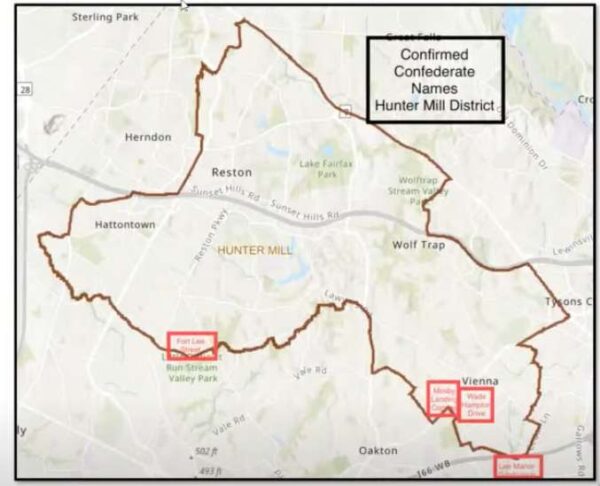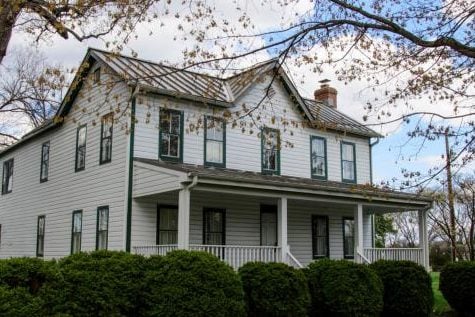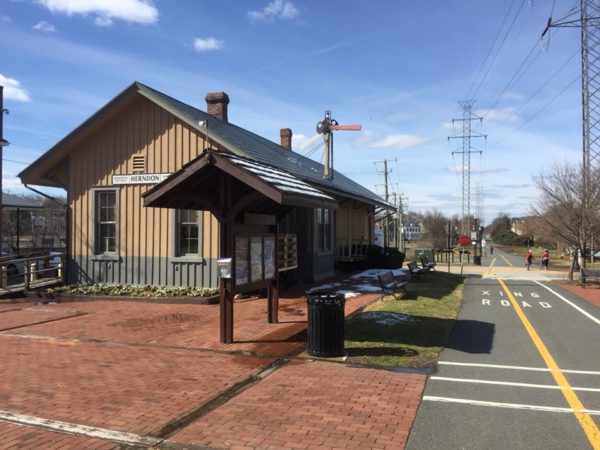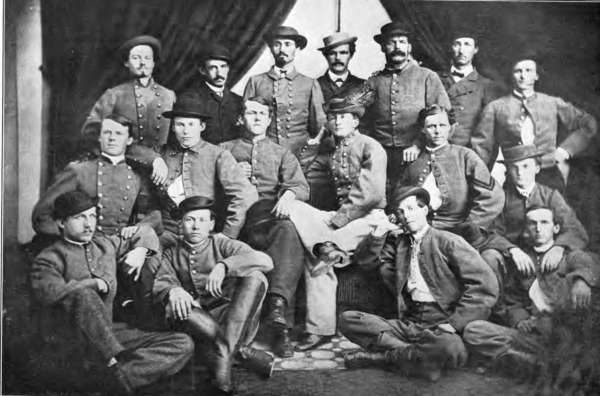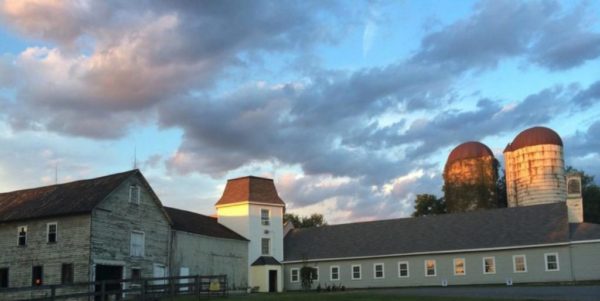
Historic Coomber Hall, a family home, and several other structures at McMillen Farm in Herndon are set to be “deconstructed” within 30 days after Fairfax County granted a demolition permit late last month.
The 171-year-old dairy-barn-turned-music-school at 1521 Dranesville Road will be disassembled this month along with several other structures, the developer that now owns the property confirmed.
Tradition Homes owner Steve DeFalco told Reston Now that a majority of materials from the barn are being relocated elsewhere in Fairfax County and will be used to construct a new barn by a private homeowner.
A new residential subdivision will be built on the site which is known as McMillan Farm, thanks to a rezoning request that was approved in 2018. The development is currently on track to be completed next summer, DeFalco noted.
A demolition permit was granted only after the developer fulfilled all obligations laid out in the rezoning proffer agreement, a Fairfax County official confirmed to Reston Now.
Under that agreement, one of the requirements was for the developer to market the sale for at least 180 days. If the main farmhouse and barn were purchased, they would have had to be deconstructed or safely moved in one piece to another property within county limits.
However, no one stepped up to purchase the structures within that time frame, giving the developer the right to remove the structures.
“It is the County’s goal to save historic buildings if feasible,” Dranesville District Supervisor John Foust wrote in an email to Reston Now. “During the rezoning process, the county requested that the owner agree to market the barn and home for at least 180 days to find one or more purchasers who might save the buildings by buying and relocating them. The owner agreed to do so. Unfortunately, the owner’s efforts were unsuccessful and no purchasers were found.”
McMillan Farm is on the county’s inventory of historic sites but not on the Virginia Landmarks Register or the National Register of Historic Places, though it is eligible for both.
The barn was partially built in 1850, and the family home was completed about 50 years later in the early 1900s. Owned by John Richard McMillen, it was the center of a 550-acre dairy farm, one of a number of similar farms that dotted Herndon in the late 19th and early 20th centuries.
“Herndon was predominantly a dairy farming community,” Herndon Historical Society Director Barbara Glakas told Reston Now. “The whole McMillan farm property — from the house to the outbuildings to the chicken coop to the barn — are…one of the last vestiges of the Herndon-area farming community.”
In the 1960s, the barn was converted into a music and dance school and recital hall by George and Mary Coomber, who had inherited the property.
The school operated within the barn for a number of years, but in 2017, the Fairfax County Office of Code Compliance inspected the site and found that many of the structures were in “various states of disrepair,” according to a county official.
The damage was potentially related to a lighting strike, according to a permit obtained for repairs related to the incident in 2012.
The county requested the buildings be further stabilized and secured, but as the rezoning application notes, the property owner had already made the decision to demolish buildings.
DeFalco bought the house and barn for $2.3 million in 2019, according to county records.
While the structures will no longer be standing on the site past the end of the month, the farm’s story will not be lost. As part of the proffer, the developer is required to erect an accessible, public memorial on the site telling the history of the farm.
“At a minimum, an information panel or panels with appropriate references to the farm’s history and appropriate landscaping and/or hardscaping,” the proffer agreement says.
DeFalco confirmed that this is the developer’s intention.
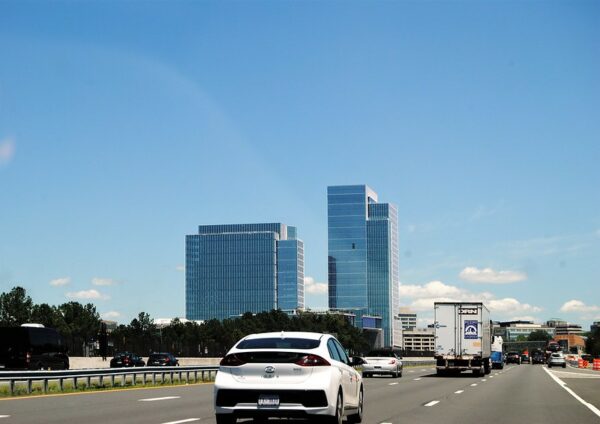
Police Investigate Offensive KKK Flyers — Bigotry-filled flyers aimed at the Fairfax County School Board were found earlier this week in the Springfield and Sully Districts, apparently distributed by the Loyal White Knights of the Ku Klux Klan. School board members and local leaders, including Fairfax County Board of Supervisors Chairman Jeff McKay and the president of the county’s NAACP chapter, denounced the flyers, which are under investigation by county police and the FBI. [Patch]
Carjacking Reported in Reston Town Center — A man with a gun told a person in the passenger seat of a 2004 Toyota Corolla to get out and drove away in the car. The incident occurred at 5:25 a.m. on June 12 in the 1800 block of Presidents Street. The victim was not injured, police say. [FCPD]
A History of Slavery in Herndon — Ahead of Juneteenth, which commemorates the abolition of slavery in the U.S., Herndon Historical Society member Barbara Glakas delves into the lives of some past Herndon residents known to have held slaves. She notes that information about individual enslaved people is difficult to find due to the limited availability of written records. [Patch]
Reston Station Releases Showcase Video — Reston Station released a video yesterday (Thursday) showcasing the vision for the mixed-use development by the Wiehle-Reston East Metro station. The video breaks the area up into the Metro Plaza District, the Reston Row District that will be anchored by a JW Marriott hotel, the health-oriented West District, and the office-heavy Commerce District. [Reston Station/Facebook]
D.C. Area Sees More Hunger During Pandemic — “More families in Virginia and Maryland, and significantly more Latino families, were pushed into food insecurity during the COVID-19 pandemic, according to a new report on hunger in the D.C. area, which a nonprofit official called a ‘dramatic shift in the face of hunger.'” [WTOP]
Photo via vantagehill/Flickr
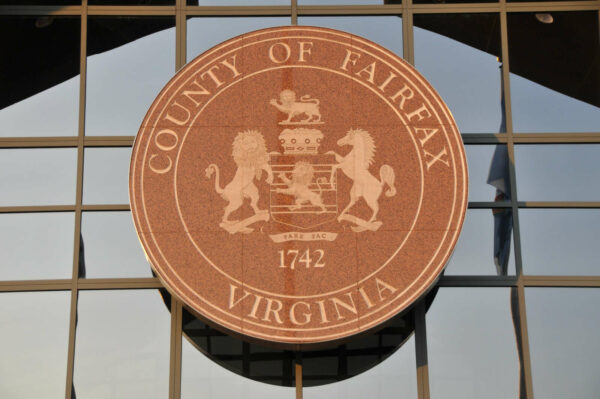
(Updated, 12:20 p.m.) The Fairfax County Government Center, where county policy is created and official functions take place, is an imposing, modern-looking building. Above the main doors is the county seal: a royal-looking crest with lions, a horse, and the date “1742.”
Unlike the building, the seal is of a different time. Adopted seven decades ago, it bears a version of the coat of arms belonging to Thomas Fairfax, the sixth Lord Fairfax and a slaveholding British loyalist who once owned much of the land that makes up Fairfax County today.
As neighboring counties and cities reexamine their logos and symbols, it seems like only a matter of time before Fairfax County faces its own questions.
When asked if there’s been discussion about further research into the county logo, representatives of the Fairfax County History Commission said it’s not on the agenda or a priority right now.
The commission is currently undertaking an inventory of local African American history after completing one about Confederate names on public places.
Fairfax County Board of Supervisors Chairman Jeff McKay wrote in a statement to Reston Now that officials are listening to the community but have yet to hear about any issues with the county seal.
America was unfortunately built in part through the oppression of people of color. We cannot separate this history from Fairfax County, but we can listen to the community on what symbols are continuing to create divisiveness and inequity. Symbols of the Confederacy, for example, do not speak to the County’s values today, so we are working to remove these through the proper processes. Currently, there are ongoing efforts to change road names as well as other Confederate symbols and the Board previously took action to remove the monument of John Quincy Marr from the courthouse. We have not heard from our community members that these same messages are felt from the County seal. We continue to invest significant resources into our historically underserved communities to ensure that everyone has the opportunity to thrive in Fairfax County.
The county selected the seal as its logo in 1949 ahead of an impending visit from the then-Lord Fairfax. It won over a dozen other seals belonging to the Fairfax family due to “its clarity when reproduced,” according to historical documents from Fairfax County Public Library’s Virginia Room.
A county flag with the seal was unveiled on June 13, 1968, the day before Flag Day, in response to repeated requests for a flag from county schools.
“We probably ought to have a Betsy Ross here to get the flag ready for Flag Day,” said Gil Shaw, the flag’s creator and the county’s director of information services at the time. “But the coat of arms of Thomas Lord Fairfax will soon fly over the lands he once owned and which became Fairfax County in 1742.”
Early colonial Virginia land history is admittingly a bit confusing due to the limited availability of written records and a lack of variety in names.
“The famous one, for our purposes, was the sixth Lord Fairfax,” explains Steve Harris-Scott, an assistant professor in George Mason University’s history department and an expert on colonial Virginia history.
“The nobles generally passed on their names to their first-born son, so when they took over the title, they were all the same names,” he said. “There was a Thomas Fairfax, first Lord Fairfax, then there was Thomas Fairfax, the second Lord Fairfax, etcetera.”
The sixth Lord Fairfax was born in England in 1693 to the fifth Lord Fairfax and Catherine Culpepper.
Through his mother’s side, he inherited about 5 million acres of land in 1710 known as the “Northern Neck,” which encompassed today’s Fairfax County. Taken from the indigenous people who had lived there for centuries, the land was a gift to Catherine’s father, Thomas Culpepper, from the restored King Charles II for his support during the English Civil War.
“[This land] is essentially bordered by the Rappahannock [River] on the south and the Potomac on the north,” Harris-Scott said.
However, Fairfax spent most of his life in England and didn’t move to Virginia until 1742, the date on the county’s logo. He also may never have resided in what is now Fairfax County, according to Harris-Scott. Read More
Fairfax County Parks Removes Mask Requirements for Fully Vaccinated Visitors — “Fully vaccinated Fairfax County Park Authority visitors will no longer be required to wear masks. Visitors who are not fully vaccinated and children under 12 years old will be required to wear a mask except as outlined in the Virginia Governor’s Order 79.” [Friends of Frying Pan Farm Park/LinkedIn]
Metro Service Increases Proposed — Metro General Manager Paul Wiedefeld is set to propose sweeping changes to both rail and bus service at a finance and capital committee meeting today (Wednesday). Possible changes include keeping stations until midnight, instead of 11 p.m., starting this summer and increasing the frequency of both trains and buses. [WTOP]
Herndon Office Plaza Sold — New York investment firm Innovatus Capital Partners has acquired the Dulles Executive Plaza office buildings at 13530 and 13560 Dulles Technology Drive in Herndon for $113.5 million. The 384,336-square-foot complex is mostly occupied by Lockheed Martin Corp., which leases half the property through 2024, and the private security company Constellis LLC, which leases 28% of the square footage under a deal that runs through 2031. [Washington Business Journal]
Reston Construction Company to Design Gas-to-Gasoline Facility — “Nacero has awarded Bechtel the Front-End Engineering and Design (FEED) contract for the first natural gas-to-gasoline manufacturing facility in the United States. Nacero’s 115,000 barrel per day plant in Penwell, Texas…will be the first gasoline manufacturing plant in the world to incorporate carbon capture, sequestration, and 100% renewable power.” [Chemical Engineering]
Remember the U.S.S. Herndon — In the wake of Memorial Day, the Herndon Historical Society tells the story of the two U.S. Navy ships named after the Town of Herndon’s namesake, Commander William Lewis Herndon, a Navy officer who died in 1857 when his ship sank in the Atlantic Ocean at the hands of a devastating hurricane. [Patch]
Hunter Mill District Supervisor Walter Alcorn hosted a town hall on Tuesday (April 20) to talk about public places in Fairfax County named after Confederates.
The discussion was based on the Fairfax County History Commission’s 539-page inventory, which was first released in December and details the history and context of each place named after a prominent Confederate figure.
The project traces its roots to last summer, when the Fairfax County Board of Supervisors directed the commission to study the legal and financial implications of possible name changes throughout the county.
The commission determined that, out of about 26,500 total named places in the county, approximately 157 streets, parks, monuments, subdivisions, and public places in Fairfax County bear names with ties to the Confederacy.
“This research confirmed…that Fairfax County was a crossroads of war,” Fairfax County History Commissioner Barbara Naef said. “Combatants of both Union and Confederates flourished, camped, marched, clashed, and suffered both victory and defeat here.”
In addition to cataloging sites, the report provides appropriate context, history, and narrative for possible name change discussions, including a dive into “Lost Cause” ideology, its pervasiveness in Fairfax County, and how it influenced the naming of places.
The Lost Cause ideology encompasses myths used to rationalize Confederacy sympathy, mainly that the Civil War was not fought over slavery, the pre-war Southern way of life is to be celebrated, and that prominent figures like Confederate Gen. Robert E. Lee didn’t believe in slavery.
“There was an urging by some to exclude it from the report altogether or soften its tone,” Naef said. “These reactions prove the point. The perspective of the Lost Cause has been embraced by generations.”
In its report, the History Commission recommended making the inventory available to the public via the Fairfax County Public Library, which is currently the case, and using the report as a guide for “a robust public process for considering future actions.”
The Hunter Mill District town hall is one of the first steps in that process, members of the commission at the meeting noted.
Within the Hunter Mill District, there are believed to be four places named after Confederates: Fort Lee Street, Lee Manor, the Mosby’s Landing condominium complex, and Wade Hampton Drive.
Fort Lee Street in Herndon and Lee Manor along Lee Highway near Vienna both derive their names from Robert E. Lee.
Fort Lee Street was named in the mid-1970s when Fox Mill Inc. developed the Folkstone subdivision, while Lee Manor is directly tied to Lee Highway, which is in the process of being renamed.
The Virginia General Assembly passed a bill in February, allowing Arlington to rename their portion of Lee Highway.
Mosby’s Landing in Vienna takes its name from John Mosby, a Confederate commander who was also known as the “Gray Ghost.” The condo complex was built on the site where legend says that Mosby and his horse hid out from Union soldiers.
Vienna’s Wade Hampton Drive is named after a Confederate lieutenant general who reportedly led a unit of 600 men and horses down the road in 1865. After the war, Hampton criticized Reconstruction and worked to suppress the vote among South Carolina’s Black population when he became governor of the state.
According to the history commission, the Town of Vienna named the street after Hampton in recognition of the Civil War’s 100th anniversary. The town is currently in the process of having the road’s name changed.
“The town has appointed an ad hoc group to look at this street name and consider alternatives,” Fairfax County History Commissioner Anne Stuntz said.
While the Commission’s charge was to examine places named after Confederates, several residents suggested that places named after individuals involved in the “Mass Resistance” movement opposing school integration should also be re-examined.
Examples include former Fairfax County Public Schools Superintendent W.T. Woodson, who opposed desegregation and still has a high school bearing his name, though schools were overall not included in the history commission’s inventory.
Commenters also mentioned Carter Glass, a state senator who developed laws intended to prevent Black people from voting, including Virginia’s poll tax.
For years, the library at Lake Anne Plaza in Reston was named after Glass. Today, that building is now the Reston Museum.
Photo via Fairfax County/YouTube
Given a quick glance, Great Falls Nike Park appears to be just baseball fields, a trail, and a parking lot near an elementary school just off Leesburg Pike in Herndon.
Visitors who take a closer look, however, might stumble across a small, odd dome-like structure mere feet from a parked Toyota — a remnant of the key role that the Fairfax County park played in protecting the nation’s capital from a potential Russian missile attack during the Cold War.
Located 1199 Utterback Store Road, Great Falls Nike Park is one of three Fairfax County parks that were once home to anti-aircraft missiles designed to bring down Russian projectiles aimed at D.C. landmarks. The other two sites can be found along Fairfax County Parkway and in Lorton.
“We felt Russia, and other countries, had the ability to potentially attack us,” David Buchta, heritage conservation branch manager for the Fairfax County Park Authority, said. “And these missile sites were specifically designed to keep that from happening. The [parks] are certainly an interesting relic of curiosity left over from Cold War times.”
Despite the recent end of one war, the world hovered on the brink of another in the mid-20th century. The Cold War was a time of tension, particularly between the United States and the Soviet Union, and the federal government felt like they needed to protect D.C. from attack.
So, the government acquired land around the city to set up sites for their anti-aircraft missile launch systems. They were christened NIKE sites after the Greek goddess of victory.
Due to the abundance of rural land available at the time, Fairfax County became the site for three of these military installations, which all opened between 1953 and 1955.
“The idea was to create a ring of defense,” Buchta said. “The range of the missiles was pretty limited, but it was enough that we could protect the entire corridor of D.C. out to the Atlantic Ocean.”
Straddling the Herndon and Great Falls border, the Great Falls site sat on land that was owned by dairy farmer Mark Turner before the government acquired it by exercising eminent domain. Another site cropped up off of Fairfax County Parkway at what is now Pope’s Head Park. The third and largest site was on land that was part of the Lorton Prison Complex.
Each of them consisted of a launch area and a control area that was located one to three miles downrange.
For the Herndon site, the control area was on Turner Farm, while the missile launch area was about a 1.5 miles west along Utterback Road.
The Herndon and Fairfax sites were smaller and very similar to one another, but a historical report produced by Fairfax County describes the Lorton missile site as a “double site” that served as “a national showpiece” for the NIKE program. In 1958, the missiles in Lorton were even upgraded to include nuclear warheads.
The Herndon site also boasted a special feature: a radar dome, a repeating structure that was intended to be reflective and bounce signals to another location, Buchta says. Read More
(Update 3/1/21) The public hearing regarding leasing Frying Pan Farm Park’s Ellmore Farmhouse to ServiceSource will take now place on May 4 as opposed to March.
Earlier: Earlier this week, the Fairfax County Board of Supervisors approved a hearing in March to discuss allowing Fairfax County Park Authority to sublease the 130-year-old, two-story, 3,300 square foot house at 2739 West Ox Road to ServiceSource as part of the county’s “Resident Curator Program.”
The terms of the lease allows the organization to transform the house into a “Community Integration Center” that would provide employment to its clients through an onsite café and handicrafts specialty store.
ServiceSource has programs across the country including theirs in Northern Virginia for more than 40 years, according to its website.
It was back in July 2019 when ServiceSource was first identified as a candidate to take over Ellmore Farmhouse.
The sublease would be for 29 years.
The ServiceSource – the “resident curator” – has proposed rehabilitating “by making ADA-compliant improvements and incorporating green-building designs in a manner that respects the heritage, historic features and appearance of the property,” reads the board agenda.
Under the lease, the resident curator also agrees to provide ongoing maintenance and property upkeep for the next nearly three decades in exchange for rent-free use.
The Resident Curator Program is managed by the Fairfax County Park Authority (FCPA). There are four properties in the program: Lahey Lost Valley in Vienna, Ash Grove also in Vienna, Hannah P. Clark House in Lorton, and Ellmore Farmhouse in Herndon.
In 2001, FCPA acquired Ellmore Farmhouse for inclusion in Frying Pan Park.
The house was first constructed in 1891 as a family home. William Ellmore, a prominent local politician who served on the Fairfax County Board of Supervisor, operated a dairy farm on the property as well until it was sold in 1945. It continued as a dairy farm for another decade before shutting down operations.
It went through several different owners, including a church, prior to being sold to FCPA.
Photo via Fairfax County Government
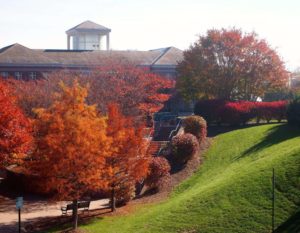
Town of Herndon is preparing for new architectural surveys, procedure guides and more for its Heritage Preservation Program.
Next Thursday (Oct. 29) the town’s consultants will host a virtual meeting to discuss updates to the program that includes new district guidelines, according to the town’s press release.
In discussions with the town and Architectural Review Board, these updates include providing property owners and the review board with:
- Clearer factors for assessing building modifications, new construction and moving or demolishing a building
- Definitions for “contributing” and “non-contributing” buildings
- Meeting schedule change
- New architectural surveys
- Creation of uniform sign standards
- More administrative approval of minor changes
- Creation of procedure guides
- District awareness campaign Expand training opportunities
The Heritage Preservation Program is designed to provide “a mechanism to ensure conservation of the town’s traditional neighborhoods and older commercial structures, providing a community identify apart from the suburban growth of the urbanizing region,” the website said.
Residents can register for the meeting through the Town’s Meeting Webcast page, once it is available.
Questions and comments will also be accepted next Thursday (Oct. 29) though the chat function.
Photo via Town of Herndon
After people may have lost sight of their New Year’s regulations, enVISION 2020 invites people to rebuild or create a new vision board.
A vision board is a guide to help people realize their goals and imagine what they want their life to look like, according to the HuffPost, which added it usually collages magazine clippings, photos and paper accents.
This session will take place on Saturday (Feb. 29) and feature music, food and guidance from two mental health professionals, according to the event page.
The session will take place at Best Life Therapeutic Services, LLC (11250 Roger Bacon Drive). Tickets are $40, and the event will run from 10 a.m. until 1 p.m.
Tomorrow (Feb. 29)
- Get to Know Your Muslim Neighbor (11 .m. until 3 p.m.) — The Reston Regional Library (11925 Bowman Towne Drive) is hosting an event where people from all cultures can come mingle and learn about history while enjoying activities such as henna and calligraphy. Coffee will be provided at this free event.
- Ramen ‘Round the World Cooking Class (11:30 a.m. until 1:30 p.m.) — Attendees will learn how to make umami-rich soup at 100 Bowls of Soup (279 Sunset Park Drive). The tickets are $75.
Sunday (March 1)
- “City of Peace” Book Talk (1 to 2 p.m.) — Trinity Presbyterian Church (651 Dranesville Road) is hosting a book event with author Henry Brinton. People will have the chance to ask questions and buy a copy for $17.
- Herndon Depot Museum Reopening (noon to 4 p.m.) — This weekend, people can attend a train show and silent auction featuring antiques at 717 Lynn Street to celebrate the reopening of the Herndon Depot Museum. People will also have the chance to learn about telegraphs, according to the Facebook page.
Photo by Andy Art on Unsplash
 This is an opinion column by Del. Ken Plum (D), who represents Reston in Virginia’s House of Delegates. It does not reflect the opinion of Reston Now.
This is an opinion column by Del. Ken Plum (D), who represents Reston in Virginia’s House of Delegates. It does not reflect the opinion of Reston Now.
A tradition in the House of Delegates that has come about in recent years is to have a speech at the beginning of each daily session during February about a Black person. Some speeches are about well-known historic figures; most are about lesser-known Black persons who have made contributions to their communities and to the state. After all, the point of Black History Month is to have all of us gain a greater knowledge and appreciation of Black persons’ contributions to our history. The Legislative Black Caucus organizes the event, and I am pleased to have been invited to speak each year at one of the daily sessions. This year I spoke about the late Gwen Ifill of PBS NewsHour and Washington Week in Review who was the first Black woman to become a national news commentator. I always appreciated receiving the daily news from her in her calm and professional manner. Not all speeches are about historic figures; one delegate spoke this year about his experiences of growing up Black.
I predict that in future years a speech will be made on the floor of the House of Delegates about the 2020 Virginia General Assembly being a transformative event in Black history. Black experience accounts for a major portion of the story in a state that unfortunately has been known for centuries for its racist policies. The first enslaved Africans were brought to Virginia in 1619, and the slave codes that were enacted to keep them subjected as slaves were inhumane.
When the tobacco fields were no longer productive, Virginia’s chief source of income became the selling of slaves into the deep South. Even the freeing of the slaves with the Civil War did not bring equal rights to Virginia’s Black population. Slave codes were replaced by Jim Crow laws. Voting by Blacks was restricted. Their separate schools and other accommodations were not equal.
Supreme Court decisions and the Civil Rights Act of 1964 and the Voting Rights Act of 1965 brought about changes that started Black people on the way to greater freedom. A successful lawsuit against gerrymandering in the state along with greater voter participation brought about a record number of Black candidates being elected to the General Assembly. Black legislators took on greater roles of responsibility in the 2020 session of the legislature.
The first Black woman was elected Majority Leader of the House of Delegates, and the first Black woman was elected President of the State Senate. While there had been a few Black committee chairs over the years in the House of Delegates, half of the fourteen committee chairs are now Black. Vestiges of Jim Crow laws that remained in the Code even though they had been over-turned by the courts are being stripped away. Localities are being given permission to deal with Confederate monuments that were the symbols of Jim Crowism.
Laws that were unevenly applied to Black persons are being amended or repealed. Black cemeteries are being cared for as the Confederate cemeteries were for many years. A commission is going to look at the teaching of Black history in our schools to ensure that it tells the whole story. Major strides are being made in this month of Black history!
File photo
This spring, visitors to the Herndon Depot Museum (717 Lynn Street) will be able to enjoy a new exhibit.
The Herndon Historical Society says that a telegraph exhibit is coming to the museum, replacing the current display.
There will be one complete telegraph machine included in the display that will sit on the desk in the bay window of the former station master’s room, according to Barbara Glakas, a historical society spokesperson.
Other aspects of the exhibit will feature antique telegraph parts, such as a telegraph key and a telegraph sounder. Visitors will also be able to learn how the code worked and try it out for themselves.
“People can type out a message on the computer key board and then they will be able to see the message on the monitor as well as hear the message being automatically tapped out in Morse code on the sounder,” Glakas said.
The updates will be revealed with a celebration on Sunday, March 1, which will include a model train show.
Herndon Historical Society member Adam Winsor is responsible for the new exhibit’s design, Glakas said.
With the exception of the Writing Herndon’s History event on Jan. 22, the museum will be closed for exhibit updates until the celebration. Glakas said that the closure is typical this time of year.
In the future, Glakas said the Herndon Historical Society hopes to team up with Historic Vienna and send messages back and forth, since the Town of Vienna wants to set up its very own telegraph exhibit.
Photo via Facebook/Herndon Historical Society
An upcoming book about Herndon wants to teach kids about the town’s history and culture.
“A Day in Herndon” is a mixed-media book that walks the reader through a day of personified farm animals from Frying Pan Farm Park who take a field trip to Herndon.
The book will be available on Saturday (Nov. 9) at a book signing celebration at ArtSpace Herndon (750 Center Street) from 10 a.m. until noon and is also on sale online for $15.95.
Readers will notice photography and illustrations from co-authors and friends Jill Vinson and Watt Hamlett, who met each other when they were neighbors in Reston. Vinson said she has since moved and now lives in Herndon.
Each animal featured in the story is excited to see something different around town, according to Hamlett.
“We have a pig who wanted to check out the art around Herndon,” Hamlett said. “We wanted to take kids on our tour through the community.”
Hamlett and Vinson published their first book — “Reston A to Z” — three years ago.
When they were selling the book at the Lake Ann Farmers Market, people suggested that they write another book together about Herndon.
“There are so many people within the community who are really excited for this,” Vinson said.
In the future, the authors hope to sell the book around town and allow organizations to sell it for fundraising purposes. They already have a deal with Green Lizard Cycling, which plans to sell the book and donate some of the proceeds to an organization of their choice, Hamlett said.
Photo courtesy Watt Hamlett
The author of “Hidden History of Herndon” will speak in Reston next month.
Barbara Glakas will be at the Jo Ann Rose Gallery (1609-A Washington Plaza N.) to discuss her book and answer questions from the audience on Nov. 13 from 7-9 p.m.
The event will be hosted by the Reston Historic Trust and Museum, which aims to foster community engagement and knowledge of local history.
This event is free and will cover a range of Herndon and Reston history from her book that features “firsthand accounts to tell little-known stories of the people, places and events that shaped the history of the Town of Herndon,” according to a press release.
Photo courtesy Reston Historic Trust and Museum
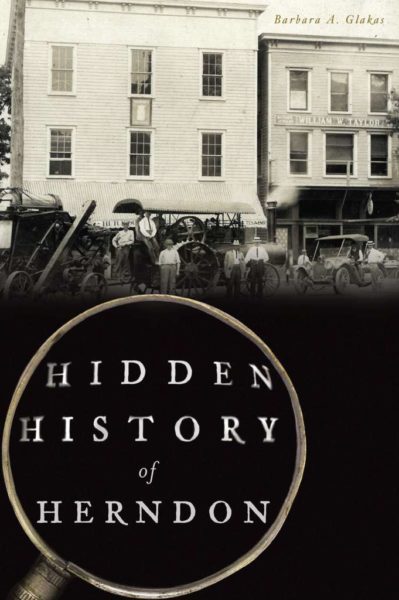 Local author Barbara Glakas dives into hidden and sometimes bizarre history of the Town of Herndon at a special event on Thursday, August 8.
Local author Barbara Glakas dives into hidden and sometimes bizarre history of the Town of Herndon at a special event on Thursday, August 8.
Glakas, the historian of the Herndon Historical Society and a retired teacher from Fairfax County Public Schools, will discuss her new book, “Hidden History of Herndon” at Herndon Fortnightly Library from 7-8 p.m.
The publication is part of the Hidden History series from publisher The History Press.
The book, which was released on March 11, including stories about the town’s naming by a mysterious individual to local unrest in the 1920s. Here’s more from Amazon’s description:
Behind Herndon’s past as a sleepy farming community hide forgotten tales of growth and progress. A mysterious stranger who passed through the village one night suggested the name Herndon, after the captain of a sunken ship. The Civil War split loyalties among the townspeople and brought an unexpected Confederate raid on the town. Prohibition brought bootleggers with it, but its repeal caused an uproar from temperance-minded residents. Lively community fairs were ever present in the 1920s, but so was the Ku Klux Klan. Local author Barbara Glakas uses rare photographs and firsthand accounts to tell little-known stories of the people, places and events that shaped the history of the Town of Herndon.
Books will be available for purchase and signing on Thursday.
Photo via The History Press
Frying Pan Farm Park Meetinghouse is one of the oldest racially-integrated Baptist churches in Virginia. In 1791, the congregation built the structure and African Americans worshipped from galleries that lined both sides of the building.
Learn more about this and more at a historical education event at the farmhouse on Sunday (April 28) from 1-4 p.m. The event, “Echoes of the Past: History Comes to Life,” walks attendees through the religious freedom movement in Virginia, the meetinghouse’s role in that movement, and the role of the church in the community.
Here’s more about the meetinghouse from Fairfax County Government:
The Frying Pan Spring Meeting House has survived changing land use, the Civil War, and major 20th century suburban growth to earn designation as a Virginia Landmark and a National Register of Historic Places site.
In 1984, the last surviving trustee of the Meeting House deeded the property to the Fairfax County Park Authority “to preserve the building and grounds for posterity.” The Meeting House and grounds are not open to the public on a regular basis, however special guided tours may be arranged by calling the park office at 703-437-9101.
Some scout badge programs include a tour of the Meeting House. A tour for the public is scheduled each spring and fall.
Change and growth in western Fairfax County have left undisturbed the Frying Pan Spring Meeting House and its adjoining springs, baptismal pond, grounds and cemetery. They have maintained their integrity for more than 200 years.
Attendees can enjoy reenactments, 18th century games for kids and exhibits. The programs is designed for attendees age eight and older. The meetinghouse is located at 2615 Centreville Road.
Registration is open online.
Photos via Fairfax County Government



